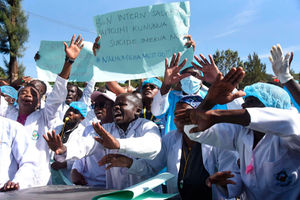WB optimistic about Tanzania’s economy as new NBS data shows improving trend

National Bureau of Statistics (NBS) Director General, Dr Albina Chuwa briefs journalists about gross domestic product (GDP) of the quarter of year during a press conference in Dar es Salaam yesterday. PHOTO|SALIM SHAO
What you need to know:
In its latest analysis of economic trends in Africa released in the US yesterday, the WB said although Africa’s overall growth had been slowing, Tanzania was among countries that had shown signs of resilience by growing at an average of six per cent.
Dar es Salaam. The World Bank (WB) has painted an upbeat outlook of Tanzania’s economy, giving credibility to growth figures released by the National Bureau of Statistics (NBS) in Dar es Salaam yesterday.
In its latest analysis of economic trends in Africa released in the US yesterday, the WB said although Africa’s overall growth had been slowing, Tanzania was among countries that had shown signs of resilience by growing at an average of six per cent.
“After slowing to 3 per cent in 2015, economic growth in sub-Saharan Africa is expected to fall further to 1.6 per cent in 2016, the lowest level in over two decades...while many countries are registering a sharp slippage in economic growth, others – Ethiopia, Rwanda and Tanzania – have continued to post annual average growth rates of over 6 per cent,” the WB said.
The report coincided with the release of new NBS economic growth data in Dar es Salaam.
NBS said GDP grew by 7.9 per cent in the second quarter of the current financial year compared with 5.8 per cent recorded in the corresponding period last year.
“The economy performed tremendously during the second quarter of this year as various sectors did quite well, and we hope it will perform even better going forward,” the NBS Director General, Dr Albina Chuwa, said.
Transport and storage grew by 30.6 per cent to lead the best performing sectors during the quarter under review.
Mining and quarrying were second with a growth rate of 20.5 per cent, while information and communication grew by 12.6 per cent.
However, in an apparent effect of the government’s decision to hold meetings and conferences at government-owned facilities and other challenges faced in tourism, the accommodation services sector slowed down to 2.6 per cent.
Similarly, real estate recorded a lower rate of 2.3 per cent, while construction sector grew by 9 per cent, down from 13.2 per cent registered in the second quarter of last year.
Agriculture registered growth of 3.2 per cent during the second quarter of 2016, thanks to favourable rains and improved extension services that boosted harvests in many areas. Agriculture contracted by 1.9 per cent during the corresponding period last year.
In monetary terms, economic output in the second quarter of 2016 was Sh26.7 trillion compared with Sh23 trillion in 2015, NBS figures show.
WB’s chief economist for Africa, Mr Albert Zeufack, said the best performing countries were those that had good macroeconomic policies.
“Our analysis shows that the more resilient growth performers tend to have stronger macroeconomic policy frameworks, better business regulatory environment, more diverse structure of exports, and more effective institutions,” Mr Zeufack said.
The WB predicts that Africa’s economic performance in 2017 will continue to be marked by variation across countries.
While the larger economies and other commodity exporters are expected to see a modest increase in GDP growth as commodity prices continue to stabilise, economic activity is expected to keep expanding at a robust pace elsewhere in the region, supported in part by infrastructure investments.




